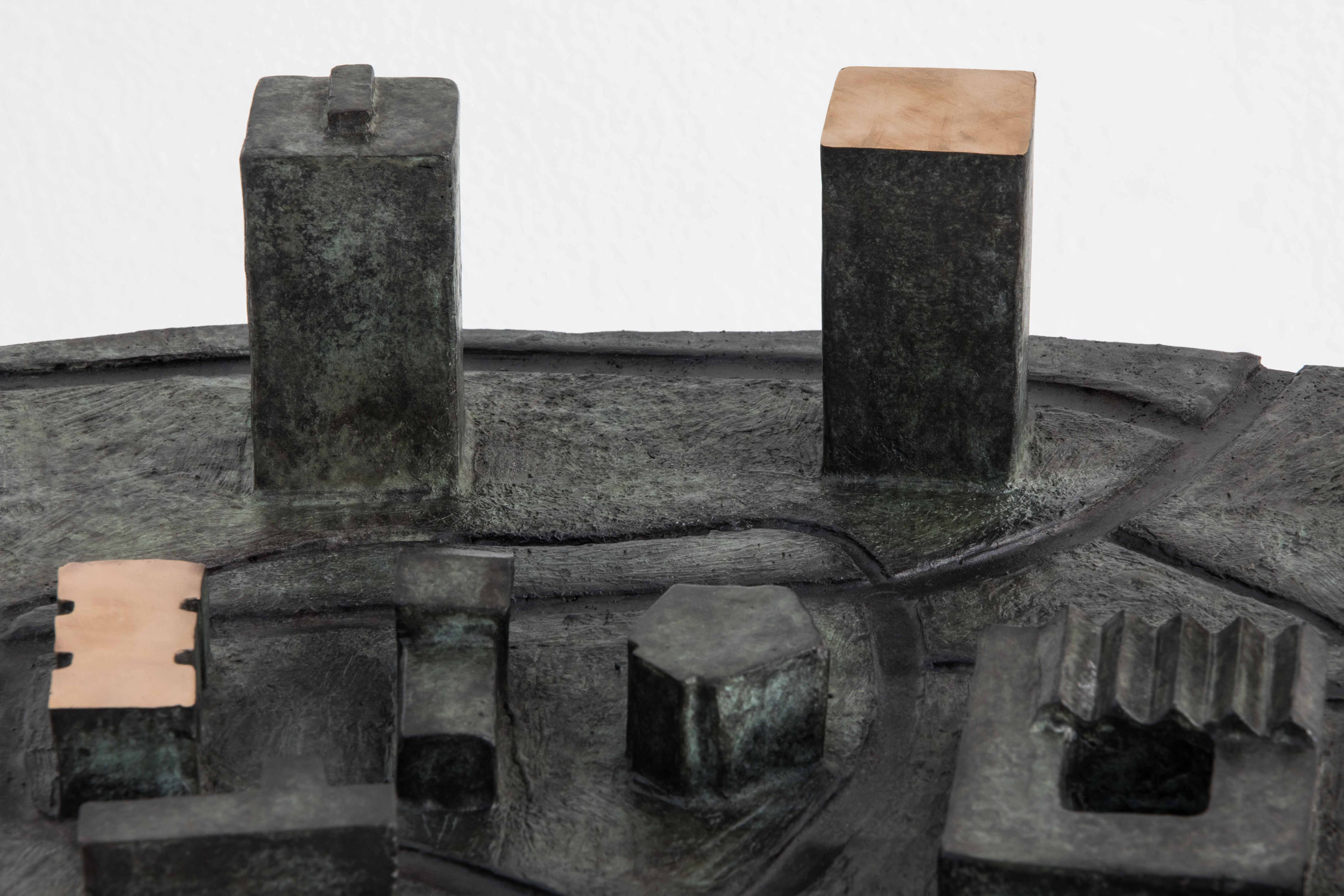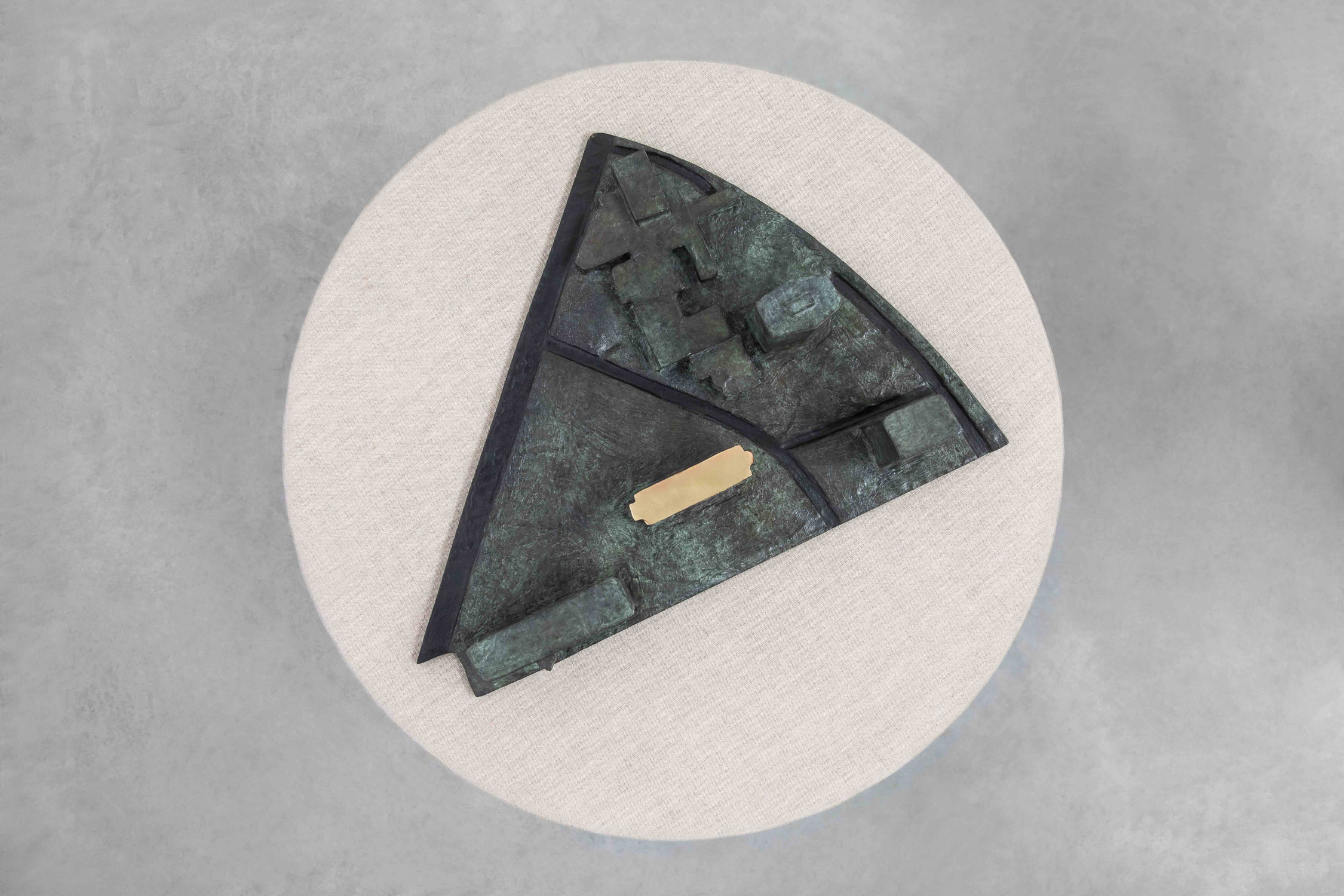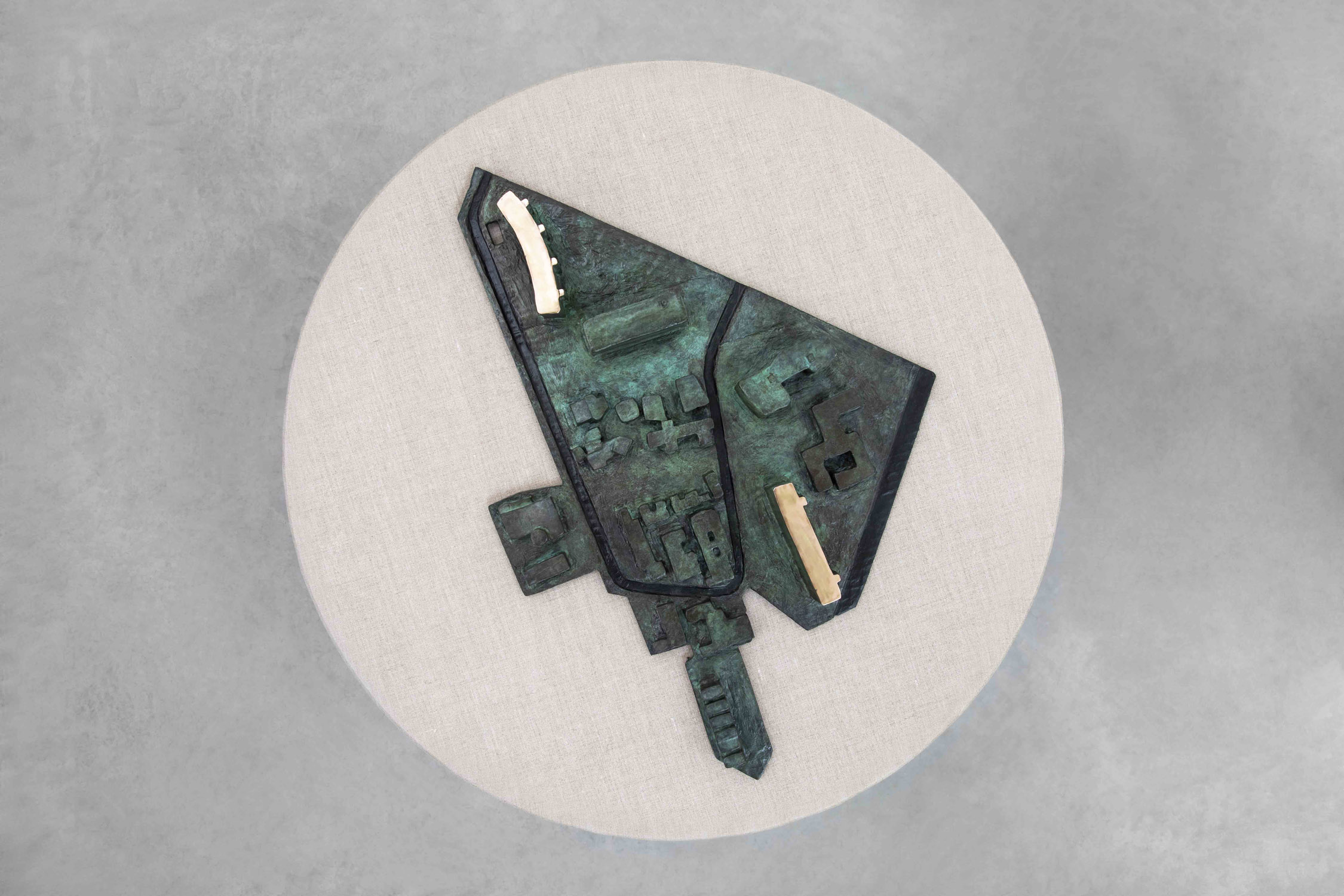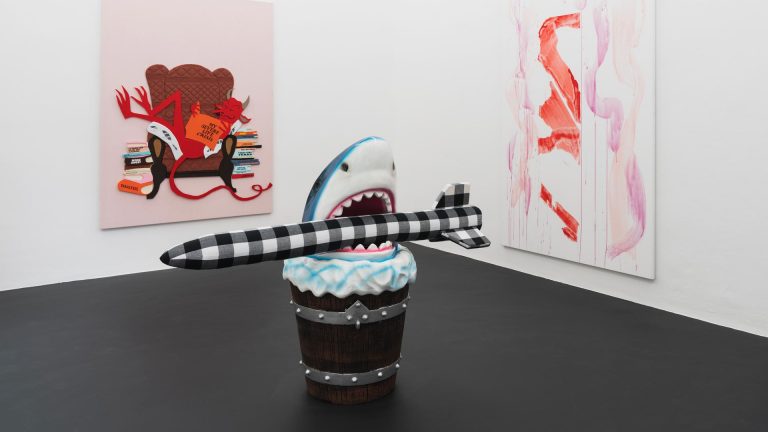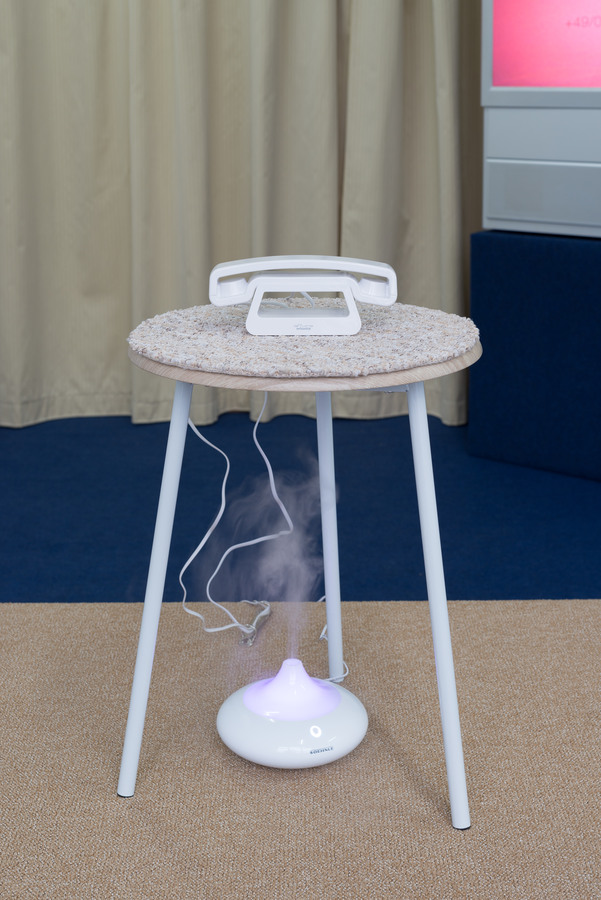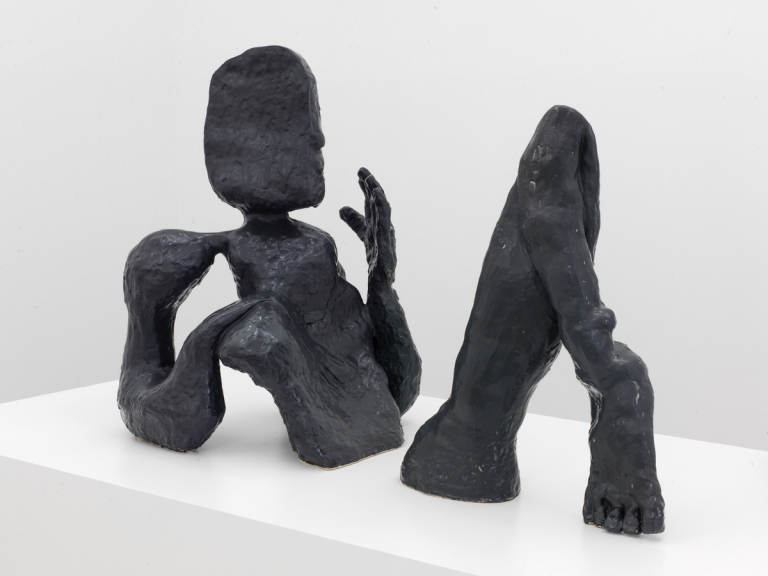Eight table sculptures: the Hansaviertel in Berlin, divided into individual sculptures along subjectively drawn borders. While these mostly follow the streets and demarcations of that district on the northern edge of the Tiergarten, their unusual partitioning creates a certain disorientation. However, those familiar with the neighborhood will quickly recognize the streets cutting through the district and identify certain buildings that rise from the patinated bronze—particularly in the much better-known southern part of the railway tracks with its model settlement, created in the 1950s for the IBA 57, featuring striking buildings by well-known (and exclusively male) architects; buildings that seem to stand almost isolated in the greenery of the park. This is contrasted by the less prominent northern part, with its larger stock of old buildings and denser new developments from the 1960s.
Originally, these sculptures by Marina Pinsky were part of a broader work complex, first presented in Brussels in 2020. In that work, Pinsky explored, broadly speaking, the gaze upward into the sky, with constellations and star maps, as well as downward to the earth, dealing with aerial reconnaissance and satellite imagery. In two interconnected series, she recreated the neighborhoods where she lived—the Hansaviertel and the Koekelberg district in Brussels—based on Google Maps images. These works, emphasizing the handmade, highlight personal reappropriation, a subjective scaling down of one’s own environment from an abstract technical image. Pinsky retained the glitches and distortions of the original images, and through her decidedly subjective translation of these images, the camera’s eye also loses a bit of its presumed objectivity.
However, this narrative—this supposedly objective discourse of ideas, concepts, and processes that allows the experience of art to be elevated from personal observation to a general discourse—takes a backseat in the case of the exhibition at GROTTO, a space located in the middle of the Hansaviertel. Detached from its Koekelberg counterpart and now situated within what it represents, the place itself takes center stage. The result is the observation of an observation, an echo chamber, self-reflection. The associated reading: recognition and comparison … isn’t that … do you see here … do you recognize there … yes, exactly. Here we are, today.
In the Hansaviertel—here, not entirely correct, referring the Interbau ensemble—live Marina, Leonie (who runs GROTTO), and I. It’s a neighborhood shaped by absences, by what once stood here but is no longer, by what lies beyond its borders and indirectly shapes its form. Topographically: the less prominent northern part of the district, usually overlooked. Politically: its counterpart in former East Berlin, the old Stalinallee with its opulent “workers’ palaces,” to which the modernist, clear, and rather modest apartments of the Hansaviertel were created as a counterpart during the Cold War. And historically: the past from which this district, this “city of tomorrow” (as a related building exhibition called it), tried to escape toward the future. “Tomorrow Never Comes,” Marina’s exhibition title for 2024, echoes that programmatic title from 1957 like a distant reverberation. The place may be the same, but the times have changed. Tomorrow has long since turned into yesterday.
I don’t know how others who live here feel, but the longer I stay, the more that absent past becomes apparent, pushing through the bright elegance of the almost uninterrupted mid-century modernism. The further back in time that abstract “tomorrow” from back then sinks, the more clearly it reveals itself as a defense against an even older, but all the more concrete, yesterday. Numerous memorial plaques and “Stolpersteine” (stumbling stones) remind us of those who once lived here—long dead, often deported and murdered. Giant trees trace avenues into the greenery where none remain. The rubble of the old buildings, almost all destroyed in several nights of bombing in November 1943, lies just beneath the undulating ground modulations of the flowing landscape architecture or is embedded as aggregate in the concrete. The large windows of the new buildings that rose from the craters, meanwhile, promise an openness that seems to hide nothing. And on their brightly tiled facades, everything can be washed away, even guilt.
As I walk through the neighborhood, the large spaces between the buildings appear as gaps and voids. The Interbau ensemble: a paradoxical knot of time that cannot be untangled, a complex place with stuck layers; a monument that clearly demonstrates that in post-war Germany, before remembering and commemorating, forgetting and repressing were practiced. A memorial—indirectly, in part unintentionally, and perhaps all the more striking because of that.
Today, the neighborhood, which is comprehensively protected as a historical monument, struggles with its own musealization. Musealization—something fundamentally different from living memory—is a double-edged sword. The necessary impulse to preserve too quickly locks into concrete stagnation. The result of blocked future horizons is a lack of the present. This, it seems to me, is what the deliberately conventional form language of Marina’s sculptures, reminiscent of the 1950s, points to: a revenant of the neighborhood’s table model, with which the design was visualized in the so-called Berlin Pavilion back then, now suspended in time as an eternal bronze.
There is also a second element in the exhibition, a mural on the back wall of the room that—in an almost dialectical manner, as abstract-geometric as the sculptures are concrete—sets things in motion again. A new plan? Perhaps a design, tipped from horizontal to vertical. Maybe a seating module, a place where people can come together. The three shapes on top are from Marcel Duchamp’s ‘3 Stoppages étalon’ (1913/14). For that work, Duchamp let a one-meter-long string fall onto a canvas and cut out the resulting shapes: new units for a different measurement, emphasizing deviation, randomness, and individuality but based on the standardized, fixed, and shared.
If this picture could now be tipped from the wall back into the space, so that, without covering it, it would end as another layer over the bronze version of the neighborhood? Wouldn’t that be a beautiful image for a lived and active community, representing a density that the neighborhood lacks, not on a historical level, but on a tangible urban planning one? A density that is the opposite of an abstract generality, meaning complexity and concrete, tangible proximity, as only a jointly animated place can offer—one that constantly renews its history and its becoming through ongoing interaction. Because even museums are, in the end, just the people who work in them, who care for their artifacts and continually bring them back to life. And neighborhoods, accordingly, are made up of the people who live in them, who come together for a certain time, acting together in this present, not another one—landing here by chance, like strings on a canvas. No, on this canvas.
Text by Dominikus Müller







